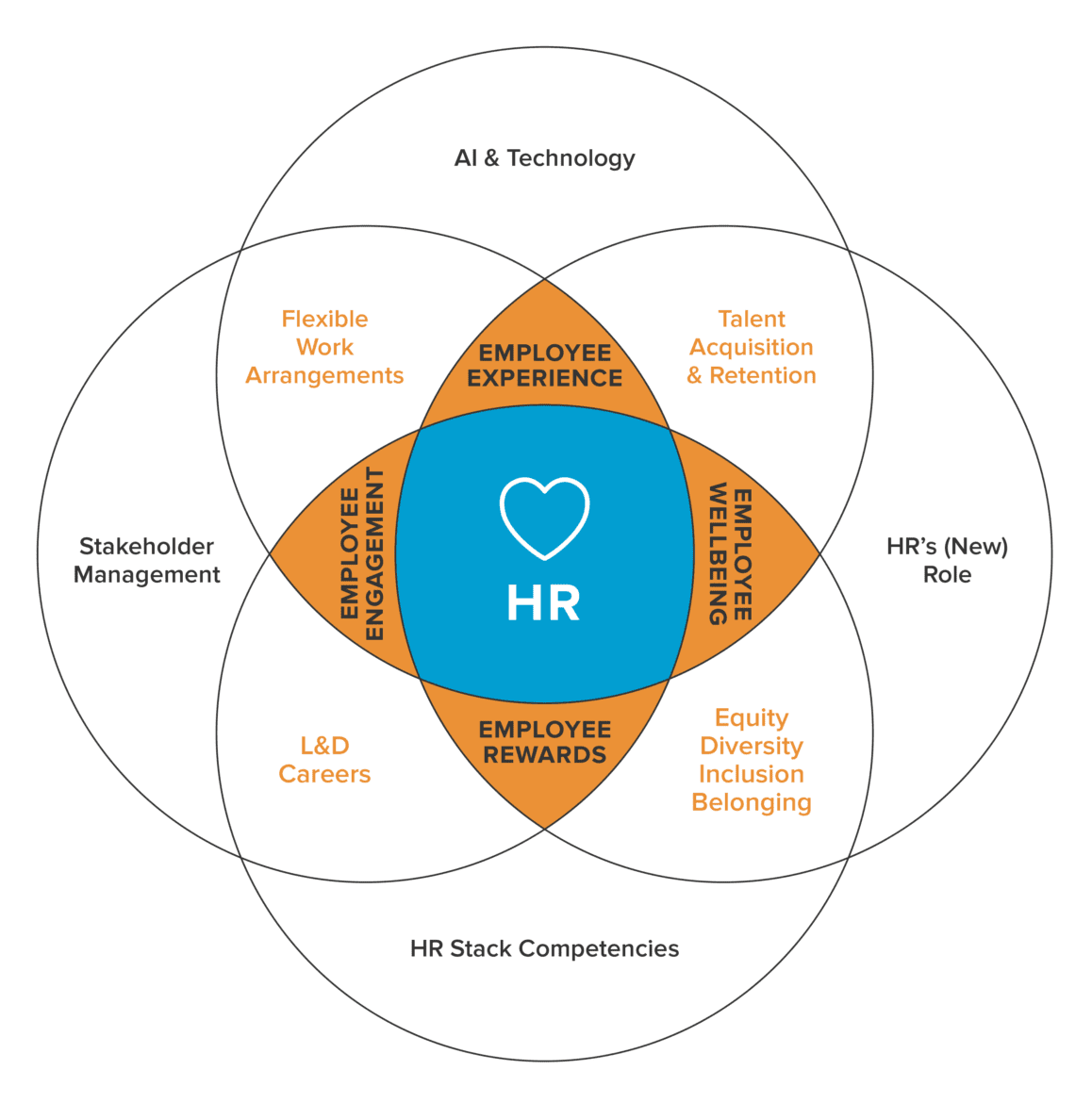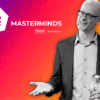

By Dr. Lisbeth Claus, Professor Emerita of Management & Global HR at Willamette University
WHY SHOULD YOU CARE?
There are considerable time gaps between HR research/HR practice and HR innovation/HR implementation particularly when it comes to the cataclysmic changes that have disrupted our ‘normal’ ways of doing things. This opinion piece aims to provide a critical evaluation of the new work patterns and the enhanced role of HR. The core of HR’s ikigai is the worker and focuses on the employee’s experience, engagement, wellbeing, and rewards for their work and talent contribution
Twelve interrelated practices of the HR Ikigai represent a place of balance where employers and employees meet for a transparent dialog and develop sustainable and purposeful relationships with the other stakeholders.
It seems like not a day goes by before I see another post about the next best thing in people operations. Many respectable, mostly consulting, organizations continue to put out their future HR trends reports reflecting on the impact of the pandemic and the world’s geopolitical unrest on the evolving nature of people management. These valuable HR trends reports appear ahead of academic research and reflect the rapidly changing patterns in the practice of HR. There are considerable time gaps between HR research/HR practice and HR innovation/HR implementation particularly when it comes to the cataclysmic changes that have disrupted our ‘normal’ ways of doing things. Having frequently written and spoken during the past decades about the evolving practice of HR through an academic evidence-based lens, I too now feel compelled to use my crystal ball to make sense of the reality of HR practice and its value-added role in organizations today. This opinion piece aims to provide a critical evaluation of the new work patterns and the enhanced role of HR.
The HR Ikigai
In this quest for sense making, I aim to organize the different HR trends into a coherent picture of interrelated elements guiding HR’s raison d’être today. In searching for pattern recognition in these HR trends, I am guided by the Japanese concept of Ikigai—a person’s pursuit of value (gai) to live (iki) depicted by four interconnected circles—apply it to HR from an organizational perspective serving as an apt north star in navigating the course toward recognizing patterns in this sea of trends. The core of HR’s ikigai is the worker and focuses on the employee’s experience, engagement, wellbeing, and rewards for their work and talent contribution. The second level focuses on the must-have HR a company needs in order to respond to uncertainty in the broader external context and current employee expectations. The focus of the third level today is talent acquisition and retention, flexible work arrangements, equity & diversity, inclusion and belonging, and learning and development. The outer level focuses on what it takes professionally from HR to add value to both the employee and the company which includes stakeholder management, artificial intelligence and technology, HR stack competencies, and HR’s evolving role. Twelve interrelated practices of the HR Ikigai are at the heart of HR’s reason for being and represent a place of balance where employers and employees meet for a transparent dialog and develop sustainable and purposeful relationships with the other HR stakeholders.

The employee core focus
The pandemic has swung the pendulum away from the employer. The inner circles focus on the worker and the talent. The ‘great resignation’ (a term coined by Anthony Klotz) has empowered workers to quit their job to focus on their own wellbeing, making many reluctant to rejoin the traditional workforce. Now more than ever, employers must focus on employees and workers in terms of their engagement, experience, wellbeing and rewards.
- Employee engagement— I have always had a love-hate relationship with ‘engagement’! Gallup has been measuring and reporting the level of employee engagement for many years. Most companies measure employee engagement or should I say lack thereof either proactively (through regular company-wide engagement surveys, frequent sentiment pulses, and great work outcomes) or/and reactively (through feedback loops and stay interviews). According to Gallup, slightly more than 1/3 of the worldwide workforce is actively engaged, while disengagement remains high (approximately 1 in 5 employees) and has not abated in the past decade despite all the focus on measuring it. Recent Gallup data for the U.S. show that the percentage of engaged workers even declined in 2021 for the first year in over a decade. It is alarming to notice that the global workforce is only moderately engaged and disengagement is so widespread. These results beg the question: why is engagement abysmal worldwide and why hasn’t it improved over the past decade? Data also show that employees are highly engaged when they join a company, but become progressively more disengaged over time. We know the different factors triggering individual employee engagement based on motivation theories and various assessments of the motivational expectations of employees. So why have the efforts by managers and HR to increase motivation (beyond the innate motivation and drive that people have) been so futile? My answer to that question is that most employees want to do a great job, but both companies and managers are the source of disengagement. Many companies are failing to provide a ‘purpose’ that employees can rally around (i.e., being a purpose-driven organization) and have control and command bureaucratic structures rather than ‘humanocracies’ (as described by Gary Hamel and Michele Zanini) that rob employees of autonomy and meaningful contributions. Many managers are creating a ‘de-motivating’ rather than an engaging environment that reduces a person’s engagement. The role of an ‘awesome manager’ includes contributing to an environment where employees are eager to show up at work and engage with others. Most organizations undervalue and neglect the role of managers, and as a result suffer from a lack of strong management capability.
Leading HR Practice #1: Avoid the ‘Peter principle’ in promoting talent into management, understand the critical role managers play in engaging and retaining employees, and provide managers with the necessary knowledge and skills for impact leadership.
- Employee experience—the employee experience is similar to a customer experience, albeit internal, with specific touchpoints in the physical environment, technology and the organizational culture as described by Jacob Morgan. In today’s work environment, employees want to be valued, have work that is meaningful and intrinsically rewarding, enjoy autonomy, and be trusted to do the right thing. In an employee experience-focused company, managers act as coaches rather than command-and-control gatekeepers. An often used measure of the employee experience is the Employee Net Promoter Score (e-NPS); namely whether your employees would recommend your company to a friend or family member as a good place to work.
Leading HR Practice #2: Let go of control and foster coaching work relationships with managers and employees based on autonomy and trust so the full potential of workers can be unleashed.
- Employee wellbeing—a focus on more holistic employee health has come to the forefront during the pandemic as an expanded duty of care obligation of employers. Wellbeing is not just about the physical wellness of employees but also about their cognitive, emotional and mental health, avoidance of burnout, promotion of work-life integration, and even financial health. This requires leading and managing with a great deal of emotional intelligence and a leadership style (as described by Richard Boyatzis & Annie McKee) focused on building the resilience and resonance of the entire workforce.
Leading HR Practice #3: Create and sustain resonance over time by focusing on renewal of others (through mindfulness, hope and compassion) and self (habits of mind, body, and behavior).
- Employee rewards—there is plenty of evidence that money is not the greatest motivator but that compensation acts more as a ‘hygiene’ factor’ (according to Frederick Herzberg’s motivation-hygiene theory). A substantial number of knowledge workers are even willing to earn less for greater flexibility. Yet, the pandemic has shown that the bottom-tier earners (minimum-wage earners and entry-line workers) in various job categories and industries have left the workforce over wage discontent and increased job pressures due to N-1 staffing (having one less person than needed to do the job) contributing to the increased appeal of unionization to protect the worker. In an employee market, the only way to increase one’s compensation is often for workers to switch employers. The disrupted economy due to the effects of the pandemic and geopolitical uncertainties (inflation, rising energy prices, and housing costs) are driving an increase in wages and salaries. Employees expect their employer to provide more substantial benefits rather than concierge-service type perks that were office-based. There is a greater push for employers to provide employee financial wellness and enrich/expand employee benefits. The compensation and benefit system based on job descriptions and pay ranges developed for a previous era (namely the 3rd industrial revolution) is outdated and in need of reengineering. The rewards conversation is also at the core of the movement for social equity and greater salary transparency.
Leading HR Practice #4: Revise you compensation and benefits systems to include salary equity, transparency, and fair negotiation devoid of unconscious biases.
Must-have HR
In addition to the usual functions of HR, the current context of work demands HR’s focused attention on: talent acquisition and retention (responses to ‘the great resignation’), flexible work arrangements (work anywhere, anytime), equity, diversity, inclusion, and belonging (to unleash the full capacity of diverse talent) and learning and development (to stay ahead of the curve and support the future jobs and careers of the workforce).
- Talent acquisition and retention—beyond meeting the core expectations of employees, talent acquisition and retention centers around having a compelling employee value proposition (EVP) that responds to a higher-level employee reason of “why do I want to work for you?” Although research indicates the reasons why employees join a company are not the same as the reasons why they stay, purpose plays a central role in the attraction and retention of talent. It is now imperative for companies to deliver a compelling work experience and make the company simply the best organization your employees ever worked. This is best accomplished by being a mission driven and transparent organization where individual differences are nurtured, employee growth is fueled in an empowering and inclusive way, and they work collectively for something really meaningful. Whether your company makes the list as a “Best Place to Work,” other measures such as manager upward evaluations, employee retention of the various roles, and stay interviews may show a more accurate picture of how your stated EVP is lived on a day-to-day basis.
Leading HR Practice #5: Develop awesome managers and leaders so the lived experience of your employees matches your stated employee value proposition.
- Flexible work arrangements— the pandemic allowed for the greatest work-from-home experiment yet and showed that productivity was not affected negatively, and that all employees do not necessarily relish the idea of returning to the office but are instead demanding greater work flexibility. As employers are responding to these demands (and seeing other financial benefits such as reduction in real estate costs for office space), three major types of location-based work arrangements are emerging; namely the office model (location-based dependent), the hybrid model (location-based remote), and the fully remote model (location independent). According to Maria P. Roche and Andy Wu, the size of the company and its growth orientation are two key organizational features to identify a company’s most effective working model. A 2×2 table leads to one of four stylized working configurations: (1) stand-alone office or campus for creativity-oriented large enterprises; (2) hybrid with flexible space for the execution-oriented large enterprise; (3) co-working environment for the creativity-oriented small startup; and (4) full remote for the execution-oriented small startup.
Leading HR Practice #6: Make strategic plans for the location and time flexibility of your work arrangements based on your company’s specific situation and develop appropriate work arrangement policies and procedures to clarify expectations and mitigate risks.
- Equity, diversity, inclusion, belonging—the conversation is finally evolving beyond the traditional race and gender D&I initiatives and introducing worldwide the notions of belonging, intersectionality, equality, equity, and allyship. Creating a diverse culture (beyond headcount, programs and initiatives) is now widely viewed as an imperative by both (external) customers and (internal) employees. A growing body of research shows that D&I can have a critical impact on employee well-being, retention, engagement, and overall organizational performance in terms of brand, purpose, innovation, and team-based performance. While diversity in the workplace is far from being achieved, HR departments now have functional activities focused on ways to promote D&I, reduce unconscious biases and, more importantly, de-bias every structural and cultural aspect of the people management system.
Leading HR Practice #7: Focus on the design of a de-biased organizational architecture to support the authenticity of the worker so everyone can bring their ‘whole’ and ‘authentic’ self to work and feel psychologically safe.
- Learning and development/careers—lifelong learning of the workforce is a key currency during times of rapid change and uncertainty. Learning and development is the new currency for employability, job satisfaction, and career mobility. Knowledge and skills are productive assets and a major part of a person’s intangible assets leading to internal and external career mobility. Having a ‘fluid’ learning model focused on employee development allows for upskilling and reskilling, making boundaryless talent fluidity of workers within and outside the organization possible.
Leading HR Practice #8: Focus foremost on agility and the development of metacognitive skills, critical thinking and a growth mindset among managers and individual contributors in your L&D efforts.
Value-added HR
According to Dave Ulrich, the basic HR functions based on the HR body of knowledge are considered table stakes rather than value added. In order to add value, HR must engage in stakeholder management, rely on artificial intelligence and technology tools, develop HR stack competencies, and assume a new and expanded role.
- Stakeholder management—has become one of the critical functions when viewing HR from a political lens perspective. While the talent (employee/worker) is a primary customer, HR has multiple other internal and external customers it must take into accounts as stakeholders : Internally–from the board of directors, C-suite executives, and managers, to externally–government compliance, union relations, shareholder expectations, and ultimately, the customers the enterprise is serving. Each one of these stakeholders vie for control and influence. These different stakeholders have diverse ‘interests’ or requirements, varying degrees of power and authority, as well as use different types of power from old to new. The interests of the stakeholders not only vary but may also be conflicting with one another. HR plays a central role in managing the multiple requirements through change management, negotiation, conflict resolution, and compromise and become what Dave Ulrich calls a ‘paradox navigator’.
Leading HR Practice #9: Balance the divergent requirements of HR’s multiple stakeholders and find a sweet spot between what is good for both employees and employer.
- Artificial intelligence and technology—a number of general-purpose technologies, such as artificial intelligence, robotics, and quantum computing, are now applied to various HR and talent management activities. Workers are expecting the same digital convenience and customization from their employers as they enjoy as consumers. HR, accustomed to a one-size-fits-all approach, can through technology offer customized services based on an understanding of the specific needs of each employee segment. The many examples of digitization of HR processes takes HR out of the picture in terms of transactions and creates space and time for HR to do more meaningful and strategic work.
Leading HR Practice #10: Look for ways to automate tier-1 HR practices, offer digital convenience and customization of employee services.
- The HR stack— in my earlier work (dating back to 2017), I described the HR competencies in terms of an HR stack that augments traditional HR knowledge and functions with skills and tools from other disciplines. The HR stack is made up of disciplines such as design thinking, behavioral economics, agile management, data analytics, and standardization-localization. While many of these concepts have made inroads into HR, many HR teams have not fully integrated these principles to better understand human behavior and successfully implement HR initiatives. HR teams must augment their competencies with knowledge derived from the behavioral sciences.
Leading HR Practice #11: Supplement your HR team with specialized expertise in the HR stack competencies.
- HR’s (new) role—the pandemic has finally brought the value of HR expertise and leadership to the forefront. The Covid-effect of the past two years has focused organizational attention on new ways of working and the importance of culture and people. During the pandemic, HR was locked into the role of (first) responder for the human work enterprise. CEOs are (finally) valuing the expertise HR leadership brings to the continued success of the organization. Now, CEOs are (finally) valuing the expertise HR leadership brings to the continued success of the organization. HR’s (new) role is moving from transactional to value-added transformational activities. HR can now become the ‘Chief Creator’ of reinvented work and HR structures. According to John W. Boudreau and Peter M. Ramstad, to realize value HR activities must be efficient (how well HR executes its core transactional tasks), effective (whether HR programs and practices have the intended effect), and have impact (optimizing the organizational capabilities through improved talent). Leading transformation under uncertainty requires HR to work—beyond its own disciplinary silo—together with others in the organization to solve the many management challenges and reconcile paradoxes. This requires broader competencies on the HR team (HR stack disciplines in addition to HR BOK), new roles, greater agility, and transparency.
Leading HR Practice #12: Transition in your HR role from being a first responder to an HR architect
The new HR Ikigai agenda
The employee core focus
#1: Avoid the ‘Peter principle’ in promoting talent into management, understand the critical role managers play in engaging and retaining employees, and provide managers with the necessary knowledge and skills for impact leadership.
#2: Let go of control and foster coaching work relationships with managers and employees based on autonomy and trust so the full potential of workers can be unleashed.
#3: Create and sustain resonance over time by focusing on renewal of others (through mindfulness, hope and compassion) and self (habits of mind, body, and behavior).
#4: Revise you compensation and benefits systems to include salary equity, transparency, and fair negotiation devoid of unconscious biases.
Must-have HR
#5: Develop awesome managers and leaders so that the lived experience of your employees matches your stated employee value proposition.
#6: Make strategic plans for the location and time flexibility of your work arrangements based on your company’s specific situation and develop appropriate policies and procedures to clarify expectations and mitigate risks.
#7: Focus on the design of a debiased organizational architecture needed to support the authenticity of the worker so everyone can bring their ‘whole’ and ‘authentic’ self to work and feel psychologically safe.
#8: Focus foremost on agility and the development of metacognitive skills, critical thinking and a growth mindset among managers and individual contributors in your L& D efforts.
Value-added HR
#9: Balance the divergent requirements of HR’s multiple stakeholders and find a sweet spot between what’s good for both employees and employer.
#10: Look for ways to automate tier-1 HR practices, offer digital convenience and customization of employee services.
#11: Supplement your HR team with specialized expertise in the HR stack competencies.
#12: Transition in your HR role from being a first responder to an HR architect.
…
The gap between traditional (transactional) and progressive (transformational) HR practices is widening and providing vanguard companies focusing on the HR Ikigai with a competitive talent advantage. As HR is evolving, based on the internal and external context of an organization, there will always be a need to scan the environment and adopt new and improved practices. It does not mean that one blindly adopts every new HR practice du jour. In a continued complex and uncertain environment, there is no ‘best practice’ playbook to copy and adopt anymore. As Chief Creator—etymologically the Greek origin of the term architect—HR must redraft its playbook under uncertainty, complexity, and constantly changing parameters. Applying the three-box innovation approach developed by Vijay Govindarayan and Chris Trimble, HR must be agile enough to simultaneously and strategically hold on to (keep), let go (stop), and innovate (start) its practices. HR must keep and improve the performance of the HR activities that bring added value and are required for compliance. Stop and selectively let go of the HR activities that no longer add value. Start, create, and adopt truly innovative HR practices for the future. This will require new ways of thinking and acting of HR to remain relevant. In Dave Ulrich’s own word (How Business Leaders Can Rise to the Opportunity, December 14, 2021), “For business leaders, HR professionals and advisors to rise to the opportunity, they need to reinvent both content (new ideas about people and organizations) and process (ways to turn ideas into impact.”
According to societal norms, I should be long retired from my professional work. Instead, I found my Ikigai. HR is my passion. I do what I love, I’m good at it, and I work with an amazing team of people. Organizations need progressive HR, and I get intrinsic and extrinsic rewards for what I do. It really is a great time to be in HR!
…
Lisbeth Claus is Professor Emerita of Management & Global HR at Willamette University (MBA) in Salem, Oregon (USA) and Visiting Professor at Pforzheim University (Germany). She is the author of two recent books: #ZigZagHR – Why the Best HR is No Longer HR (with Lesley Arens) and Be(Come) an Awesome Manager: The Essential Toolkit for Impact Leadership (with Scott Baker and Peter Vermeulen). Both books are available from Amazon. Contact info: lclaus.@willamette.edu or via LinkedIn.
Written by: Lisbeth Claus
Employee Engagement Employee Experience HR Strategy Inclusion & Diversity Leadership Learning Talent Wellbeing
Previous post

- 1934
labelArticles today2022.03.23.
Why We Continue to Struggle with Change
By David C Forman, bestselling author “Fearless Talent Choices” WHY SHOULD YOU CARE? In today’s volatile environment constant change is the new status quo. In this article you will learn [...]
Similar posts

labelArticles today2024.10.21.
The success-recipe to build agile and future-ready organizations in 2025 and beyond








Post comments (0)